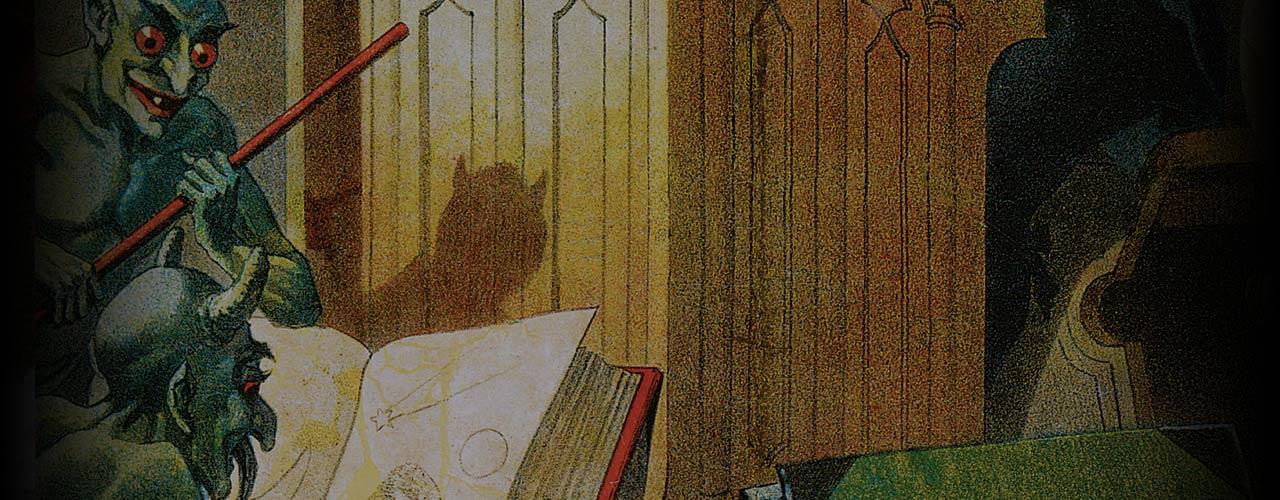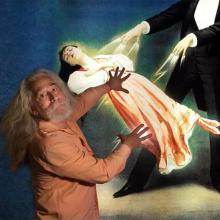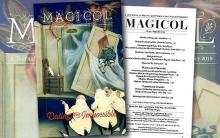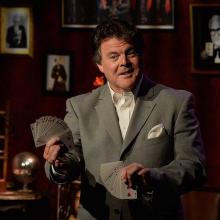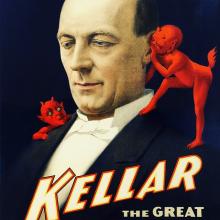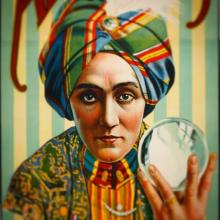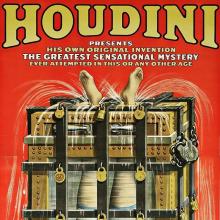Submitted by James Alan on
Magic Magazine | June 2006
By Michael Claxton
“It is easy to throw a lot of superlatives together and go into a verbal rave, but here is a man who rates all the superlatives in the dictionary. Here is truly the man most thought about, talked about, and looked up to in magic.” That’s what Bruce Reynolds wrote in The Linking Ring nearly 60 years ago, and now, over a decade after his death, Dai Vernon remains the towering figure of 20th-century magic. A vocal champion of hard-won skills, streamlined sleights, and natural close-up moves, he insisted that a magician was first an artist. Stretching the limits of manual dexterity and melding the worlds of conjurer and card cheat, David Verner transformed his beloved craft and symbolized its mid-century transition from grand stage spectacle to intimate tableside deception. As Karl Johnson put it most recently, Vernon became “magic’s Picasso, its Hemingway, its Duke Ellington.”
His story is the story of 20th-century magic, and David Ben has begun a richly satisfying account of its first half. Dai Vernon: A Biography is the fruit of years of careful research in the magical literature, the voluminous correspondence of magic’s close-up elite, and the Vernon family archives (including Jeanne’s unpublished essay “I Married Mr. Magic”). The result is a detailed, humanizing portrait of a genius and the age that hailed him as its conquering hero. Much like Jim Steinmeyer’s recent books Hiding the Elephant and The Glorious Deception, Ben carefully places his subject in context, showcasing Vernon’s contemporaries in all their brilliant eccentricity, and showing the Professor as the true witness to and shaper of magic history that he was.
The biography traces the first one-hundred years of the Vernon story, from his grandfather’s immigration to Canada from Ireland in the 1830s to the infamous 1941 construction accident that nearly destroyed Vernon’s performing career. Vernon himself was a gifted story-teller, and Ben effectively captures that still familiar voice, generously quoting from the magician’s own writings. I especially enjoyed the portrait of a young David Verner as an intensely restless and curious child—a portrait which clearly prefigures the man who would never stop in his quest to reach comprehensive perfection in his art. This is, after all, the boy who made his own telegraph at age five, who fooled Thurston with the magician’s own card moves at age six, and who had mastered all the sleights in Erdnase by age twelve.
Vernon’s was a diverse mind and talent—an athlete, engineer, artist, gambler, and magician. He comfortably inhabited a number of social worlds, equally smooth in the parlor of a New York millionaire or in the smoke-filled back room of a Midwest saloon. He made friends with magicians, of course, but also with actors, politicians, artists, businessmen, and jailbound hustlers. He worked his craft in many venues—cutting silhouettes in Southern churches, charming patrons with close-up at the swanky Casino de Paree, and trying out his Harlequin act (briefly) at Radio City Music Hall. Vernon’s restless drive to broaden his repertoire of card table artifice took him all across the country. His search for center-dealer Allen Kennedy in Kansas City is the most famous episode, but he also pursued a host of other characters: Old Dad Stevens in Chicago, Jim Whitey in Miami, Ping Pong in French Lick Springs, and “Slip the Jit Harry” in New York. From each of these underworld legends Vernon gleaned a valuable dodge or subtlety. From all of them together he learned a sacrificial dedication to the craft.
Such dedication was, of course, Vernon’s greatest legacy and also his greatest flaw. Had he never married and fathered two sons, few would fault him for his wanderlust and frequent disregard for making money. But sadly, his obsessions had a personal impact upon his family. Jeanne Vernon was a talented woman who learned to mark cards, design masks, put up with a pet monkey, and to do other things associated with Vernon’s odd lifestyle. But the blunt reality is that she and the boys were often second to a deck of cards in his affections. Some of his friends, such as the sensitive genius Paul Fox, took him to task for it, but others seemed content merely to seek out the creations of his dexterous mind.
In fact, David Ben’s portrait of magic’s emerging close-up world—the famed New York Inner Circle and its colleagues—is both fascinating and surreal. Here we see the minds that would usher in magic as we know it today, a group fiercely devoted to the tough discipline of sleight-of-hand. They were brilliant and temperamental, sometimes wise and occasionally childish. As Vernon steals upon the scene in the 20s, we see magicians like the fading legend T. Nelson Downs, hungry both to keep his name alive and to stay in the loop on the latest miracles. We see the two Eddies—McLaughlin and McGuire—willing to devise any machination to discover a desired secret. We meet a young Charlie Miller, hopelessly green around the sharps, but a technician extraordinaire. There’s Faucett Ross, loyal but not always let in on all the real “work.” Or Max Holden, one of Vernon’s earliest champions, who was quick to pass the crown as fast as he bestowed it.
The picture that emerges is one of an insular, rarefied network of cardmen, often seemingly oblivious to the world around them, constantly plotting, scheming, and eavesdropping to scoop the latest sleights. It is a world of double-crosses (as Malini sabotages a Vernon card trick to make himself look good), elaborate conspiracies (as the Inner Circle sets up Walter Scott to upstage Vernon), profitable subterfuges (as Fred Braue secretly tapes Miller when he tips Vernon’s work), embarrassing pettiness (as Houdini pitches a tantrum when called on his sloppy sleights), and practical joking (as Vernon makes newcomer Cardini believe that every American magician is a pasteboard genius). The intensity of this group comes through vividly in the judicious quotations from contemporary letters. Their correspondence is a goldmine of personality and obsession, revealing a cast of people I thought I knew, in all their brilliant neuroses. Ben’s book is a fantastic portrait of Vernon, but it is even better as the documentary of one generation doggedly coming to terms with a revolutionary.
Perhaps only a true card devotee can fully appreciate such a world, but it is still a marvelously told story for anyone interested in magic history or in the absorbing life of, arguably, its greatest star. While I would have liked to hear more from Jeanne’s writing, and while I felt that there weren’t quite enough of those wonderful photographs, those are minor items of taste. David Ben’s writing is engaging, and the number of voices that emerge in this book is impressive. Every important personality and every important development in 20th-century magic is explored here, and Ben deftly connects Vernon to each one. He concludes that Vernon was both a link to magic’s past and a portal to its future. After all, he is the man who bridges Downs and Roth, Leipzig and Jennings, Malini and Skinner. Most importantly, this biography helps us see how Vernon became the Professor, and I look forward to the second volume to watch how, ensconced on his couch at the Magic Castle, Vernon lived out that name.
Recommended

